The Sims 4: City Living, the game’s latest DLC pack released a few weeks ago, takes the focus away from suburban home life and into city apartment life. In a recent conference call with reporters, Maxis Producer Grant Rodiek told us all about City Living’s new content, why certain elements were left out of the pack, how this expansion pack fits in with previous ones, and more.
This interview has been lightly edited for clarity and length.
With all the available ideas and different ways to do expansion packs, why a city? What was your inspiration?
So we always try to look toward the past, like we look toward the expansions that we made in the past that were ones we enjoyed making and that our fans tended to like. We sort of have a rough stack ranking of things that our fans like, and then some of those have longer technical investments they require, some of them have different – basically have different tech requirements – and we were ready and able to do the city around this time. It was also something that – players have been playing The Sims 4 for a couple of years now, and the apartments were a really cool way to sort of shock the day-to-day lives of Sims.
The Sims, really, it’s all about the day-to-day life, and if we don’t shock that, if we don’t change that every now and then it can get a bit repetitive. So the apartments and everything we put in there was a really nice fundamental change to how people play.
The other thing is that, we were inspired by Late Night, which also happened to be the third expansion for The Sims 3, and it tried to do a city as well, but it didn’t do a city very well at all. It didn’t even really look remotely like a city, and we were sort of – we were hoping that we could one-up ourselves, and I really think we did this time. So it was sort of a mix of something that our fans like, something that was the right place in the ark for the technology, something that spiced up the day-to-day life of our sims, and also something that was a really cool challenge that we thought we could succeed and beat, and all those things aligned and it was just sort of the right play.
The other thing is we’re a very global game, and I think something in the past that we haven’t done as well as move past is the sort of Americana of the game. And something we’ve really tried to do better at with The Sims 4 is to better acknowledge and represent the world that is our players. And so the last pack we tried to make sort of a European-style world.
This one we went more toward the urban setting. We were really inspired by all the cultures and ethnicities that kind of make up a city. And then we were looking more toward the East for inspiration, cities like Japan – oh, not Japan. Cities like Tokyo or Taipei, Shanghai, San Francisco, Vancouver, really cool cities. And so it was another opportunity to sort of sample from the rich culture of the world and our player base, and the city was a really great place to put all that effort.
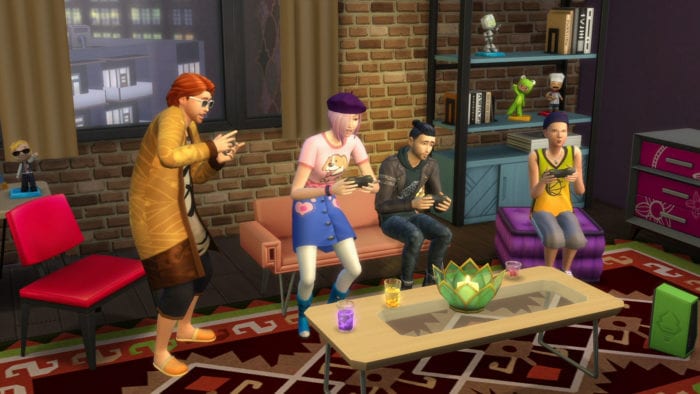
You’ve mentioned how the expansion is full of dynamic street life. Can you talk a bit about how it’s more dynamic than what players have encountered to date in The Sims 4?
We did this in a couple ways, some a little bit more simpler [sic], some a little bit more headache-y. On the difficult side, we added in a system we call Festivals, and effectively what this does is a Festival will pop up, usually a couple every week, and it will just appear in the street outside your window, and you can leave your apartment without a load if you live in the same neighborhood. If you don’t live in the same neighborhood you could load to it, and you’ll have friends who’ll call you to go visit, and you’ll have all sorts of notifications to go there.
But in the past, where a sim had to go visit like a bar or a museum, we have suddenly a food festival that appears with different food carts, and different activities, and competitions, and things you can buy, and things you can discover, and it’s right there outside your window. And we have five different festivals in three of the four new neighborhoods. So that’s sort of the more complicated tech version that we did.
The simpler solution is that we designed a lot of our content to be good on the street and on the outside, and so we have a lot of cool content [inaudible] apartment life, but outside the window, once you leave that apartment, we tried to fill it with a lot of content that encourages you to go out into the streets. We do this a lot of times and get together and we designed a lot of content specifically for large groups of sims, which is why we have like foozball and the bonfire and cool interactions.
Well, here we designed things like basketball, the basketball court where you can go play on the street. We designed the ability to go have a cart where you could sell paintings and crafts and goods. That was inspired by like artists you see in the city in Paris where they’ll be out in the street selling their paintings. We’ve got murals, where you can go sell your graffiti. We’ve got protests, which supports our new career, which is something you do out on the street. We have a new buster stand where you can go out there or we have the electric piano that you can take out. We’ve got the – we’ve got weird new characters that walk around, we’ve got tourists that walk around, and so we have sort of like the bullet point, back-of-the-box features that appear.
But we also just have a lot of subtle gameplay design focused toward ‘We want you to leave your apartment. We want you to go to the streets and see what’s there and just have a lot of fun.’ So it’s sort of a mix of those two features.
A lot of simmers would say they would think about celebrity status and reputation when they think about a city. Why didn’t that fit into this pack?
It’s a few things. First off, it’s a sort of an inside thing. It’s a little bit of a boogey man for us. We were talking to our players last week, and we just did a European tour a few weeks ago, and we asked them about this, and we got some clarification. But players had some frustrations with some celebrity elements in The Sims 3, and without really understanding why they didn’t like it, we didn’t want to jump in and do it again, because you don’t want to do it wrongly if you know people didn’t like it. So that was one of the reasons.
The other thing is that, I think celebrity mostly makes sense for the city because it’s something that we’ve done in the past for Sims, but I don’t necessarily it has a whole lot to do with the city per say. Like, I don’t ever see celebrities in San Francisco, and I’ve lived here 11 years. Really, unless you live in like LA or certain parts of New York, you probably don’t see celebrities too often. It was one of those things where we really wanted to focus on what it means to live in a city, day-to-day, why are cities special and different from living in a residential neighborhood in, say, Willow Creek or Oasis Springs.
You know, a lot of us aren’t native to San Francisco but grew up in small towns and rural towns and moved out to California and San Francisco – a very urban environment – and we tried to capture that sense of leaving your home and moving your way up from terrible apartments and terrible landlords and finding the opportunity that the city provides that, say, a small town in Texas might not. And that was more of our focus.
We wanted to make the normal feel exciting and aspirational. And we also didn’t quite understand fully why our players were sort of frustrated by this celebrity stuff in the past. And so, we wanted to do something different, and we didn’t want to step into a landmine of making a mistake that wasn’t going to make our players happy.
Something we’ve really tried to do with Sims 4 is – we don’t want to just repeat what we’ve done in the past that’s boring for the creative team, but it’s also harder to get players excited about something we’ve just done. We’re trying to take… We’re trying to do that always borrowed… We’re trying to do that something borrowed, something blue, something new type thing, although we’re not getting married here.
That was one of the areas where ‘Well, we don’t necessarily use celebrities this time. Maybe we could do it differently elsewhere, but for now we’re going to focus on the festivals, the culture and just that city lifestyle.
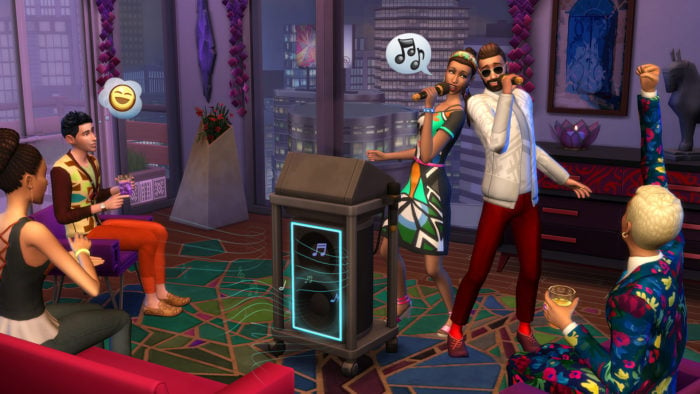
Considering all the new content, how long do you think it takes to experience it all?
You know, I’m really not sure. And it depends on how much you cheat. A lot of our players do not play without cheats, and it’s really funny when I’m at press events they’re always asking about cheats, and I sort of made a pact with myself when I started 10 years ago that I don’t use cheats, but it quickly distances me from the way the game is played by some of our players. A lot of players only play with cheats.
You’ve got five festivals, several of which have competitions that you can try to max out and win. And it will take you a couple of weeks in the game just to visit all the festivals, and then fully taking advantage of all the stuff ahead. You know we watched our players in play test and then on the final version, and a lot of times in the festival, they didn’t know that ‘Oh crap, I’m not done yet!’ And then they would have to wait until the next week to go back and tease out all the other stuff you can do with the festivals.
Something we’ve really tried to do this time is that in the past we basically said ‘Hey, go buy a new crappy house.’ But eventually you can just build up on the house and turn that small lot into a huge mansion. And something we tried to do here was actually have a sense of progression and aspiration with the apartments themselves.
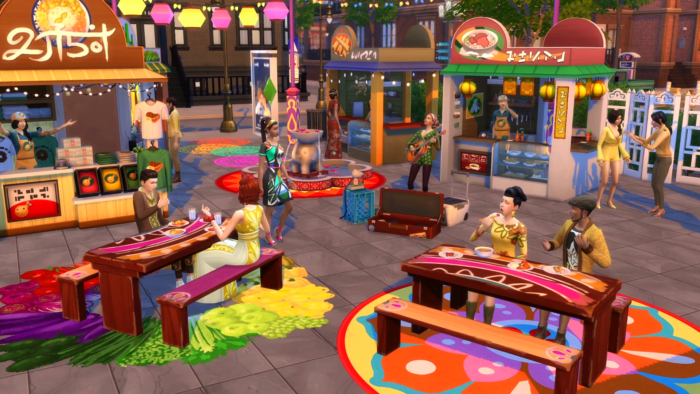
I think there’s a lot of game here, and I think players – something we do, and we have sort of weird, semi-goofy mechanisms for which we do this – but something we’ve implemented in Sims 4 development is the notion of making sure our players get the right value for what they buy. We’re sort of obsessed with making sure they get more value than what they pay for, because we want our players to be happy. We want them to be playing the game for a really long time, and when we come up with more expansions, we want them to say, ‘Man, that last one had so much great stuff in it. This next one’s definitely worth my money.’
We’re definitely not trying to do the quick cash out. It’s definitely something that we’re obsessed with.
How do you know when you’ve hit that sweet spot? How do you know when you’ve hit that right amount of content for what players are paying?
The way we do this mechanically is sort of behind-the-scenes based on things that we’ve sold in the past and back when we had more individual sales items, we try to determine the individual rank and size or the heft of a feature that is not based on what it costs us to make, but it’s sort of based on the value to the player.
I think a lot of teams can really mistake ‘This was really hard to make’ for what our players will value it has. So we try to think about how much gameplay this provides, whether they’re going to be excited for this, whether they have this feature yet, and we sort of put a numeric dollar value against it, and then a couple of us will argue about it. And we try to be consistent. We try to refer to my evaluation as the Roderick Ruble. And my boss, Lyndsay Pearson, hers is the Pearson Peso. And Lyndsay tends to be way overvalued from what I do, so I tend to be a low-baller, so we argue about that. But effectively, over time we will say ‘We think this will be the value we’re going to get from this.’ Then we play it and see this is where the value is actually at. Should we go up or down? And then we have additional phases of development where we go back and reassess and look at features and try to really sharpen and refine.
And then we also bring in external reviewers, external Sims players. We take the game to different community events. And so we basically try to do as much as possible to put our own gut instincts into that, against it, look at the sort of economic stuff of the past and how our players react to it in the past, and then also look at bringing in new players and fresh people to bring in and tell us where we’re at. And hopefully somewhere in there we align pretty decently on how we’re doing.

You mentioned a little bit about the long-term progression of apartments, but can you talk about the moment-to-moment difference of living in an apartment as opposed to in a house?
This was one of the key areas we really wanted to differentiate ourselves from Late Night in Sims 3, because the Late Night apartments – in the words of our creative director – were basically more-restrictive housing. So sort of like, why would people want to move into a crappier house.
So we did things from the start and we did them simple. So we implemented a landlord, who is a character who can come help fix things when they break, and you can build a relationship with him, and we thought that was kind of a cool story, real-world moment. We put in physical objects that you cannot remove that are things like leaky pipes and rat holes and not-so-trusty electrical fuse boxes. But then also good things like romantic fireplaces that just make an apartment a little more romantic.
So we tried to do that to give the apartment a sense of character and style. And then from there we took it the next step where we implemented lot traits, which is a really cool feature that you can implement on any lot in the game, not just apartments. These are things. You can assign… and this is sort of our new cool build/creative feature. You can assign up to three traits to any house, and it’s sort of inspired by if you ever go to Craigslist looking for apartments or you’re looking for real estate listings and people will describe a house with a sort of ‘This has a great view and beautiful open space and great for creative types who want to sit on the balcony and paint.’ And we kind wanted to create that sort of story with the lot, so you can have a place that’s a great party place, and parties are great there. Or good internet connection that helps you build skills and learn things more quickly. Or it’s good for painters because it’s inspiring.
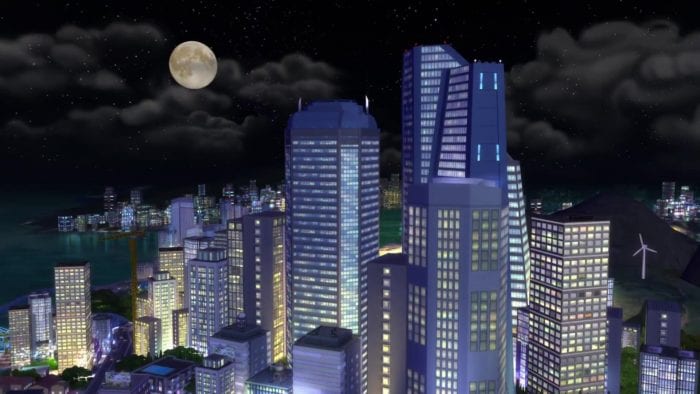
And then we have some silly ones and gremlins who break stuff, ghosts. And so some of our players like telling stories or challenging their sims or even just trolling their sims, so we give you some lot traits that are in no way positive, they just make things worse for you. So a really cool mix gameplay-wise. Some of these will challenge you gameplay-wise, and some of these are just great stories.
We have rent, and rent means there’s a little more back pressure financially, not just a one and done. Now you have rent as well. But the other cool thing is it’s not just about the physical. There’s a sense of community in the apartments, and that’s pretty much inspired by Seinfeld and Friends and How I Met Your Mother and Big Bang Theory and basically every American sitcom that has ever been in an apartment. And we have the notion of neighbors coming over to hang out or bug you. You can give a neighbor a key, and they’ll just walk in whenever they want. You might come home and find them there.
Your neighbors could be having really loud woohoo late at night, which will wake you up and upset you. They can be playing rock music and partying. You can go yell at them and create a tense moment. Or you can wake them up and be annoying.
And so there’s just a sort of sense of there’s a community for them to be there, there’s a physicality to it, there’s more backpressures. It’s one of the things where we try to create a foundation of telling stories. And we try to push those stories to you. You don’t have to just create them yourself. The game will come and trigger them almost like a director in a movie.
You were saying there are moments where things get very goofy. What are some of those moments?
Goofy is our bread and butter, and something that we always try to put a little bit in there just because it’s funny. So we have the human statues that hang out in town, and if you tip them and help them out, you can unlock a costume yourself to go around and do it. We have the notion of a chopstick skill and fight skills, so sims who do not have the qualifications for that might be breathing fire or using chopsticks like an absolute idiot. We have a robot atop a toilet that is inspired by HAL 9000. One of my favorite playtesting moments ever in the history of The Sims was when one of our playtesters said, ‘You know, the talking toilet was my best friend.’
We have – your neighbors can be having really loud whoo in the middle of the night, which is kind of funny and gross and weird. We have created a new batch of very goof characters. We have a dude who walks around town in a full body raccoon outfit, and we call him Trash Panda, and he’s just a very strange person.
So we try to build a world with funny moments, weird moments. Moments that make you laugh. For some of you who remember this classic Simpsons episode, there is a new death where if somebody makes a low-quality puffer fish, it can kill you.
Yeah, we’re always looking for jokes that make sense and that we think our fans will appreciate. So little winks, little inside jokes.
A lot of the community was upset that there was no elevator except for in apartment complexes. Do you think fans will get over that?
Especially when they’re looking at announcements, a lot of the players kind of edit the feature list. And it can be frustrating as a creator, especially since we spent a whole year on this. It can be frustrating sometimes that they can sometimes focus on what they don’t have instead of what they do. But then again, I don’t expect them to understand or even care, because it’s not really that interesting, about all the reasons we did or didn’t do a thing.
But we look at the boards. We know what they care about, and sometimes we make the choice that we think we have something we can do that’s cooler, or we think that there’s a thing that will be better in the end. On like the elevator question, we actually debated about this and talked about it a lot. And we knew that players would want to be able to place an elevator, but in reality, most people don’t have elevators in their homes, and it would have been very, very expensive and complex to make it work. And we felt that that time was better spent making the festivals cool and interesting, adding new objects that they didn’t have in the game, adding things like basketball courts and all the different dunks, adding the ability to sell paintings on the street with the craft cart.
It’s always a trade-off, and we don’t do it will-nilly, but we try to have good reasons for it. I think that most players will not be bothered by it. I actually worked on the elevator in both Sims 2 and Sims 3. Personally, I just don’t’ think it’s a very interesting object. I get why some people like it, and it’s great that you can have woohoo and you can die in it. It’s just a trade-off. It’s always us trying to figure out where we can make the most people happy with things that are really cool and surprising.
And we have made [elevators] in The Sims 2 and The Sims 3. And with The Sims 4 we wanted to be different, so we’re not doing it just to be different, but there are things where – sometimes we’re going to prioritize the new thing because our players already have that old thing. But we understand. We get it, and maybe we’ll do the elevator at some point. Maybe we’ll do those other things at some point. But I sincerely believe that they will get their money’s worth, and that there is a lot to love in City Living.
The scope of the world is so huge. What were the challenges in building that? Did you scale back/add anything last minute?
This was the most difficult world we have ever made in the history of The Sims. It was just an overwhelming undertaking, and it’s just like this sort of phenomenal – I’m super proud of that team, and I think they have a lot to be proud of.
For example, we had to build what we call shell technology. The apartments are essentially just enormous models that then have to interface with our build system so that people can build on top of those. This changes our camera system. This changes LODs, which is effectively when things pop in in-frame based on where you are in the distance, which has huge implications on our video card and performance implications for how well the game runs.
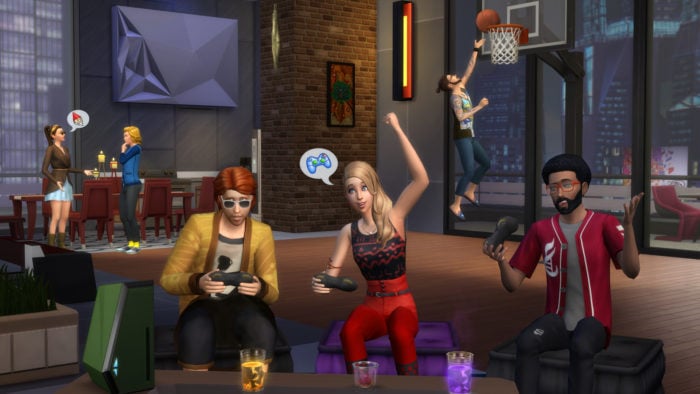
We had right up until the very last minute, right up until the wire, all kinds of stuff like ‘Oh my god, we have to touch up the background map painting.’ So we effectively have paintings in the very background for the distance views. Like a lot of movies do that, for example. And so we had to touch that up, make sure that was clear. At certain camera angles, there might be empty spots that we had to fill in. Our visual effects team was placing sims in the world to create a sense of traffic. They designed a real traffic simulator for all the cars that are driving, so the cars will stop and use the stop lights. They don’t just plow through each other.
There were just so many details and places to examine, and our art director was just doing passes and passes and passes and passes. ‘Oh god, we missed this camera angle! Oh god this shot doesn’t work. Oh god! Oh god! Oh god! Oh god! Oh god!’
I don’t think we compromised on anything, and maybe in some cases we should have. It’s one of these things where we basically went all out. We just sort of went crazy on this one, and I’m sure I will get yelled at by some manager for the budget implications.
What’s your favorite feature about the pack?
I really like the apartments. I think they’re a really fresh take on apartments from the past. I think they’re above and beyond better than our past apartments, so they’re pretty exciting for me.
I’ve been playing The Sims 4 for years now, and I like how they change my day-to-day life. I like how they change my decisions, and also just sort of from a sense of developer pride, just seeing – things from the apartment touch every development discipline on The Sims 4 team. Every single person. So there’s just a lot of collaboration stuff.
For hardcore open-world fans, this feels almost like you’re in an open world. Do you think that will get people to come play The Sims 4 now?
Maybe. We really tried to put in some stuff to make it, like, reduce the load times, reduce the loading instances, bring more of the content to you. You know, it’s still not a true open world experience, and players who want that true open-world experience still won’t get it here. I think it will alleviate it for some people, but we’re not positioning it according to that, because I don’t want players to misconstrue and come off as lying or – I don’t want players to think we’re saying ‘Yep, we’re done. We did it.’
So it’s sort of a whole thing where hopefully people notice it, hopefully people appreciate it, hopefully it makes them happier with the experience. We’re always trying to look at little details like that that will hopefully improve the experience for more people.
